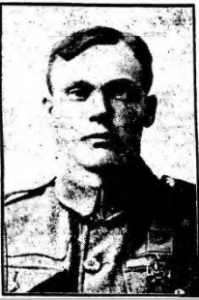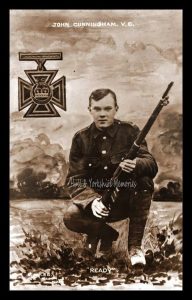
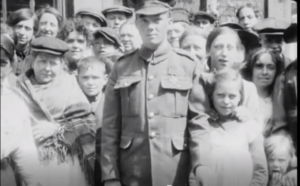 John Cunningham, VC (28 June 1897 – 21 February 1941) was a recipient of the Victoria Cross (VC), the highest and most prestigious award for gallantry in the face of the enemy that can be awarded to British and Commonwealth forces. Cunningham was 19 years old, and a Private in the 12th (Service) Battalion, (the Hull Sportsmen’s Pals Battalion), the East Yorkshire Regiment, 31st Division, during the Battle of the Somme, when the following deed took place for which he was awarded the VC.
John Cunningham, VC (28 June 1897 – 21 February 1941) was a recipient of the Victoria Cross (VC), the highest and most prestigious award for gallantry in the face of the enemy that can be awarded to British and Commonwealth forces. Cunningham was 19 years old, and a Private in the 12th (Service) Battalion, (the Hull Sportsmen’s Pals Battalion), the East Yorkshire Regiment, 31st Division, during the Battle of the Somme, when the following deed took place for which he was awarded the VC.
‘On 13 November 1916, the opening day of the Battle of the Ancre (the final offensive of the Battle of the Somme), attacking from opposite Hebuterne the 31st Division was to seize the German trenches and form a defensive flank north of Serre. After the enemy’s front line had been captured, Private Cunningham went with a bombing section up a communication trench where much opposition was met and all the rest of the section were either killed or wounded. Collecting all the bombs from the casualties, Private Cunningham went on alone and when he had used up all the bombs he had he returned for a fresh supply and again went up the communication trench where he met a party of 10 Germans. He killed all 10 and cleared the trench up to the new line. His conduct throughout the day was magnificent.‘
The Yorkshire Post on the 20th January 1917 reported that he had captured a trench of 30 Germans, making most of them prisoner. The Hull Daily Mail reported that it was 28 prisoners, who surrendered when he threatened to bomb their dug-out.
John Cunningham, who was usually known as Jack, was the eldest son of Charles Cunningham, a licensed pot hawker and his wife Mary Ann. He had six brothers and one sister. John came from a traveller family. He was born on the 28th June 1897, in a caravan, parked at Swains Yard, off Manley Street, one of the back streets of Scunthorpe (this stack yard no longer exists). It had been the family’s custom to reside in Hull during the winter and take to the road when weather permitted, visiting Beverley, Driffield and other East Yorkshire towns. The family had a pot stall on Beverley Market, and Jack had lived for a time in Flemingate and went to Beverley Minster Boys School. The family later moved permanently to Hull and John attended schools at St James Day School, Wheeler Street (later Newington High) and Chiltern Street School, Hull. The original Chiltern School had been demolished and a modern primary school built in its place. The family lived at 62 Edgar Street, Hessle Road, behind St James Church, Hull, which has now been redeveloped. His education was often disrupted as his parents were often on the move. 
After he left school John became a hawker, like his father before him. He was described a “good lad”, “cheery” and the families main source of income. He was good at sports, and liked racing his pet whippet “Meg”. He enlisted with the 3rd Hull Battalion when he was seventeen. He carried out his initial army training at South Dalton near Beverley and later served with the East York’s, guarding the Suez Canal in Egypt, from December 1915 to March 1916. They then moved to France and the Western Front.
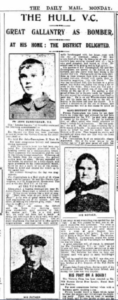
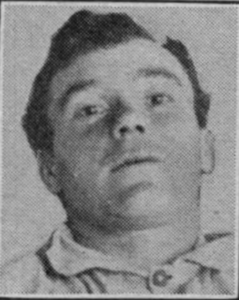
On the 2nd June 1917, Jack was one of 350 men and women to be decorated at a special public ceremony of investiture at Hyde Park. It was a beautiful summer’s day and aircraft of the Royal Flying Corps patrolled the skies overhead in case of a surprise German air attack. A Guards Brigade provided suitable music for the occasion. The ceremony was also filmed (see video clip). Cunningham was one of the first to be decorated by the King and the other recipients included several other Somme V.C. winners (Hughes, White, Allen and Bradford VC). The crowds were able to follow the presentation by reference to a programme. Each recipient had a number and this number was displayed on boards in various parts of the crowd. This way everyone present knew who was who. It was interesting that owing to superstition the number 13 was dropped from the proceeding. (Roland Bradford VC was number 14 in the list instead of 13. Unfortunately the altering of his number did not prevent him from being killed by a stray shell nearly six months later.) When Cunningham’s turn came to be paraded in front of the King, there was a roar from the crowd who had read of his deed in their programmes. The King talked to the ‘Hull Hero’ for some time.
Later that evening, Cunningham left London with his parents who had also been present at the Hyde Park reception, to return home to Hull for leave and the City was to give him a huge welcome. Although his train arrived at Paragon Station at 1.28am, on a Sunday morning, the crowds and and a band were waiting to greet their ‘local hero’.
On emerging from the station, at the former Anlaby Road entrance, a great roar went up and he was immediately hoisted shoulder high and carried him home. An enterprising local firm had redecorated the family house and neighbours had placed flowers outside the home. The initials VC were placed after Cunningham’s name on the Edgar Street shrine. This included nine men from the street who had so far fallen during the war. The Roll of Honour was decorated with flowers and a crowd remained outside his parents house for the rest of the day. At the time he was also living at 75 Walker Street, Hull (1918 Absent Voters Electoral Records). During the same leave, he visited St James School and although later there were plans to erect a plaque to Cunningham at Wheeler Street School, they were not carried through. The local cinema, the Hull Palace, showed the film of the Hyde Park investiture, while Cunningham was on leave. John Cunningham, his parents and a younger brother, Matthew, were also invited to be guests at a crowded meeting of Hull City Council at the Guildhall on Wednesday 5th June 1917, where he was given an official welcome on behalf of the City and also presented with an Illuminating Address. Cunningham gave a short message of thanks and was applauded continuously. In his remarks the Lord Mayor, Alderman Francis Askew, said this to Cunningham in his public address:
“…..It was open to him, as well as to any of the rank and file, not only in the Army, but in civil life, by his zeal, industry, and determination, to achieve higher honours in the future. There was no doubt that his deed would be talked of for many years to come…”
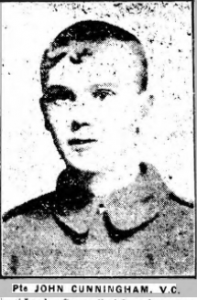
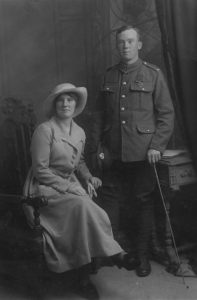
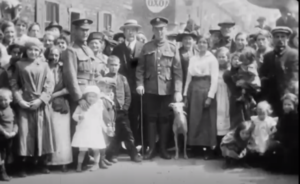 Cunningham returned to service and was quite badly wounded at the end of the war. He was demobilized in 1919. In the same year, he married Eva Harrison. They had two children, a daughter Annie who died in infancy and a son John who was born in Hull in 1920. He wore his VC to his wedding. He arrived in Beverley with his new wife at the Railway Station, the special guest of the Mayor of Beverley, who welcomed him with, “How are you my gallant VC?” A large crowd filled Station Square to cheer his arrival and bunting decorated the streets. The Playhouse showed a film of the Cunningham wedding which had been produced by Ernest Symmons. The Playhouse’s advertisement proclaimed “this is the Hall that goes to the expense of taking local events.”
Cunningham returned to service and was quite badly wounded at the end of the war. He was demobilized in 1919. In the same year, he married Eva Harrison. They had two children, a daughter Annie who died in infancy and a son John who was born in Hull in 1920. He wore his VC to his wedding. He arrived in Beverley with his new wife at the Railway Station, the special guest of the Mayor of Beverley, who welcomed him with, “How are you my gallant VC?” A large crowd filled Station Square to cheer his arrival and bunting decorated the streets. The Playhouse showed a film of the Cunningham wedding which had been produced by Ernest Symmons. The Playhouse’s advertisement proclaimed “this is the Hall that goes to the expense of taking local events.”
Shortly after his return from the Army, it appears that Cunningham was having difficulty in settling down and fitting in with civilian life. He was regularly offered free drinks where ever he went and this did not help his poor health. As early as July 1919 we find him being summoned for physically abusing and beating up his wife who he claimed “left him three times a week”. The Local Magistrate granted Mrs Cunningham a separation order with a weekly allowance of 25 shillings a week. At his appearance in Hull court, Cunningham wore his V.C. Summoned again nearly 16 months later (November 1920) Cunningham was ordered once more to pay his wife a maintenance grant. Cunningham, who was again sporting his V.C medal, said in his defence that he only had an income of an Army pension of £2 per week. He received this pension for being wounded in both legs and in the lungs. However these wounds did not prevent him from being involved in a brawl with an ex soldier a couple of weeks later when he was put on remand for hitting the man on the head with a bottle. A non commissioned officer, or private soldier, Jack also received a £10 annual pension, in virtue of receiving the Victoria Cross.
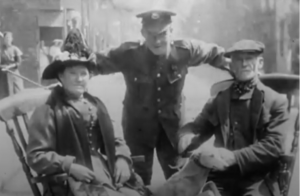
In March 1922, Cunningham became the first of the Somme V.C. holders to be sent to prison, for failing again to keep up payments to his wife. he was accused of being drunk and caring little for his wife and child. He replied in Court “How can I always be drunk when I’ve got no money?” The arrears amounted to £10. Seven years later, in November 1929, Cunningham once again made the local headlines in Hull. This time he was the victim of two fellow hawkers who made off with his share of the value of a quantity of lino that the three had agreed to sell and split the proceeds three ways. (Cunningham regularly sold wares on Anlaby Road, outside the ‘Tigers Lair’, which was then a Railway club). Cunningham was not in court on this occasion, as he had a more pressing engagement with the Prince of Wales, at a dinner for Victoria Cross winners!
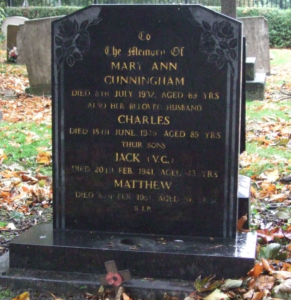
Jack Cunningham died at 5 Beaufort Terrace, Campbell Street, Hull on the 21st February 1941. He was only 43 years old and had been ill for some time. This building like most in Hull associated with Cunningham has disappeared. John was buried three days later at Hull Western Cemetery, in an unmarked grave (grave No: 17509, compartment No; 180, Hull Western Cemetery). His name is however mentioned on his parents’ memorial stone nearby. His medals are in the possession of the York Army Museum. Like most V.C winners his obituary was published in The Times.
Cunningham was the first man, connected with Hull, to win the Victoria Cross in the Great War and he was one of four members of the East Yorkshire Regiment to receive the nation’s highest military honour. Unlike Hull’s other VC winner, Jack Harrison, he does not have a commemorative plaque, at the Hull Guild Hall. In view of the time that has elapsed since Cunningham’s death and the end of what appeared to be a fairly tragic post war life, it would seem appropriate for Hull, to remember Jack Cunningham VC, despite of his misdemeanors. After all, he was a Hull Hero when he returned home in 1917, having brought honour on himself, his regiment and his home town.
Some Jack Cunningham VC links with a video clip of his homecoming.
http://www.britishpathe.com/video/hulls-vc-private-cunningham-enjoys-well-earned
http://en.wikipedia.org/wiki/John_Cunningham_(VC_1916)
http://www.scunthorpetelegraph.co.uk/New-memorial-town-s-VC-war-hero/story-19650115-detail/story.htm
Also, Jack Cunningham’s life and story, by Dawn Layland, Education and Outreach Archivist, – www.durhamrecordoffice.org.uk
Other VC’s connected with Hull
Jack Harrison, VC, is Hull’s famous Victoria Cross winner. His story is dealt in more depth elsewhere – https://www.ww1hull.com/directory-newtest/listing/harrison-vc-mc-john/.
Less well known are the following two men awarded the Victoria Cross for conspicuous gallantry.
Private, Samuel Needham, VC, 203329, 1st/5th Bedfordshire Regiment, lived at 6 Astley Street, Albert Avenue, at the outbreak of the war. Sam Needler was born at Great Limber, Lincolnshire on the 16th August 1885. He was the son of Septimus and Mary Needham and
worked liked his father as a stable hand on several local farms. At the start of the war, Samuel Needham’s parents had died, and he lived with his married sister Florence Baron, at 16 Astley Street, Albert Avenue. He enlisted as Private, 5023, Army Service Corps, Horse Transport, and went to France on 13th January 1915. He was wounded and returned to England. After recovering from his wounds, Sam was posted to the Bedfordshire Regiment in Palestine, and won the Battalion’s only VC of the War. Against almost overwhelming odds, he beat off a Turkish attack, allowing his platoon to evacuate wounded safely. Samuel Needham, VC, never returned to Hull. He was killed by an accidental gunshot wound at Katara, Egypt, on 4th November 1918, aged 33 years old. His sister Mrs Baron, collected his Victoria Cross, at a ceremony held in Hull, on the 13th February 1919. The event was reported in the Hull Daily Mail the next day.
http://www.rodcollins.com/wordpress/samuel-needham-vc-lincolnshire-victoria-cross-winner
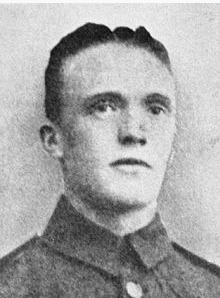
Lance Corporal, John Elisha Grimshaw, VC, married in Hull while recovering from wounds. He was born on the 20th January 1893, in Abram, near Wigan in Lancashire. He came from a mining family and enlisted in the army on the 13th August 1912. He was serving in India, when the war started, as a Signaller, “C” Company, 1st Battalion, Lancashire Fusiliers. John Elisha Grimshaw won his Victoria Cross at Gallipolli on the 25th April 1915, whilst landing on ‘W’ Beach. He scrambled ashore and managed to cut through the enemy barb wire, under murderous fire. He was one of only 32 survivors, from 800 men who landed on the Beach. John was later evacuated from Gallipolli with severe frost bite, and posted to Hull, as a Sergeant, Musketry Instructor. In Hull, he met and married within three months, Margaret (Maggie) Stout, who lived at 3 Paradise Place, Commercial Street, Hull. They married on the 26th August 1916 in the Parish of Sculcoates, Hull and moved to Grosvenor Street, Beverley Road, Hull. They had two children, Mary born in 1917, and a son Leslie, born in 1918. John Grimshaw, VC continued his military career, finishing as a Lieutenant Colonel. He died in London on the 20th July 1980. His wife Maggie, lived to see her 100th Birthday and died in February 1993.
